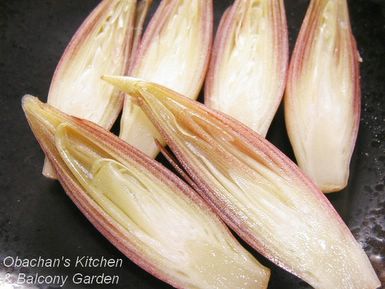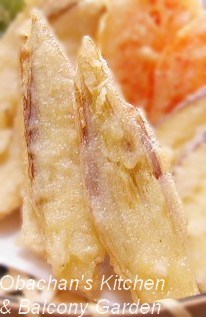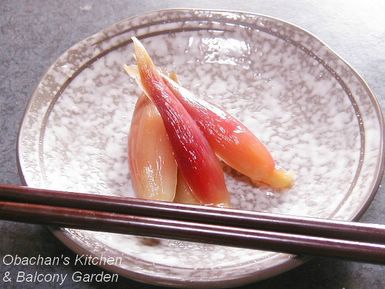Another recipe from a Japanese recipe site. It really appealed to my curiosity because the combination of the seasoning ingredients looked strange and too simple to me but so many reviews there were almost worshipping it. Yes, it's just honey, soy sauce and raa-yu (hot sesame oil or chili oil) that are used to season this salad. All you need to do is to heat drained canned tuna with those three ingredients in microwave for one minute and mix in blanched and chopped cabbage. (Actually in the original recipe chili oil is added after the tuna mixture came out of microwave.) How does that sound? And they say, "You could eat half a cabbage at one time all by yourself." Well, let me tell you. They didn't lie. I didn't use half a cabbage but I did use a quater of it and ate it all at one time. The hot sesame oil (or chili oil) is the key. And honey. Using sugar would not be the same, I guess. Gee. I wonder how the recipe author came up with this idea. Some people ARE creative, aren't they? Categories: Japanese |
Tuesday, March 17, 2009
Simple and Tasty
Posted by
obachan
at
3/17/2009 02:12:00 PM
16
comments
![]()
Labels: Vegetables
Thursday, February 12, 2009
Daikon and Hakusai Gyoza
Another recipe from the Jan. 25, 2009 issue of Lettuce Club. It's a low-cal dish that uses thinly sliced daikon radish as gyoza (potstickers) skin and more minced hakusai (Chinese cabbage) than ground meat for the filling. Good recipe for those who can slice daikon in 3 mm thick disks or who have a vegetable slicer like this one.  I loved this gyoza wrapper! :D It was crispier and probably healthier than regular dumpling skin. The only problem with this dish was having to use salt to soften the daikon wrappers and minced Chinese cabbage. I should have used less salt when seasoned the filling... My gyoza tasted just a little too salty, and probably the salt wasn't very good for my relatively high blood pressure. ------- (Added Feb. 14) Wow! I didn't think this many people would be attracted to this dish. OK. Let me add a little more information here. About daikon wrapper: You don't need to peel the daikon. Wash it well and slice it with the skin on. Spread the thin daikon disks on a flat surface and sprinkle both sides with a little salt. Sorry, I don't remember how long I waited and the recipe doesn't say anything about this... Just try folding one of them. If it folds as much as the wrappers in these photos do without breaking, it's ready. (Now the original recipe didn't say anything about this but I washed off the salt with running water when the daikon wrappers became soft enough.) Pat-dry them with paper towel. Then spread them on a flat surface and sprinkle one side with potato or corn starch using a tea strainer or something just to thinly cover the surface. This should keep the filling in the wrapper. ;) Put the filling on each wrapper and fold it. About the filling: The ingredients are ground pork, minced veggies (hakusai cabbage, green onion, ginger and garlic), salt, pepper, potato (or corn) starch, sesame oil, sake and soy sauce. The minced hakusai needs to be softened beforehand and you do this by mixing in a little salt and leaving it for a while (again, the recipe doesn't say how much salt or leave it how long). While waiting, you can mix other ingredients and seasonings in a bowl, and when the minced hakusai is soft enough, squeeze the water off it and mix in. I didn’t wash off the salt from the hakusai there and that’s why I wrote “I should have used less salt when seasoned the filling” above. Frying: And when you fry the gyoza with a little vegetable oil in a frying pan, fry both sides of the gyoza first to slightly brown them, then put a lid on the pan to sort of “steam-fry” them over low heat until the filling is done. I didn't need to add water because enough water came out from the veggies. And the best tip I can give you here is: If the filling comes out, just put it back in the wrapper! Yep, THIS is the secret. LOL ** One question. What do you call these in English? Sorry. Maybe I should give more explanation. They are not used for baking (though I assume that they could stand the heat of the oven.) They are usually used for keeping prepared food or ingredients like chopped vegetables or filleted fish or wrapped gyoza that are ready to be fried, etc. Most often we put food in them, cover with plastic food wrap and keep in the fridge. They are called "stainless vat (pronounced 'batto')" or "kitchen vat" here, but I've been wondering if the word "vat" came from English. Categories: Asian-inspired |
Posted by
obachan
at
2/12/2009 11:20:00 PM
20
comments
![]()
Labels: Vegetables
Tuesday, February 10, 2009
Pickled Cherry Tomatoes
Some of you might remember what I wrote about my experience with cucumber pickles before. It was a little -- well, VERY -- disappointing experience. Actually it was almost traumatic, considering the amount of time I spent on the conversion. (It was an American recipe I found on the net.) Since then, I had avoided thinking about pickling again, until I saw a real tempting photo of pickled cherry tomatoes with a recipe in an old issue of a cooking magazine the other day. Isn't it amazing how photos can influence or motivate people to do something? Or maybe it's just me? I get tempted so easily... SOMETIMES (not always, I guess).  Well, this time I'm really happy that I got tempted. The recipe required no conversion, the instruction was very simple and the pickles turned out oh so good, though I needed to add much more sugar than the recipe called for to suit my taste.  And these pickles in the jar are so photogenic! That really counts.  And you see the jar I chose this time? Hey, I'm learning... ;) Categories: Western-inspired |
Posted by
obachan
at
2/10/2009 03:48:00 PM
8
comments
![]()
Labels: Vegetables
Saturday, November 08, 2008
Store-bought Summer Roll Salad
It's my complete day off today after six consecutive days with both daytime and night-time jobs back to back (well, mostly). You can imagine how lazy I'm determined to be all day today. Oh, I deserve it. Definitely. I bought this for my lunch. This healthy dish will accompany "spaghetti aglio olio e peperoncino" which I'm going to make myself. And I have ginger ale in my fridge. International lunch, huh? ;) BTW, I didn't know until 10 minutes ago that this type of fresh spring-roll like food is called "summer rolls" in English. So "spring rolls" usually means the deep-fried version, right? Categories: Other-areas |
Posted by
obachan
at
11/08/2008 10:58:00 AM
11
comments
![]()
Labels: Vegetables
Saturday, September 27, 2008
When I Need Healing...
Home-baked French Bread, Ratatouille and Apple Preserve I have to admit that my work has been pretty stressful. But I also have to admit that I'm better off now -- compared to how I was a year ago... in September 2006. Now I have days off more irregularly but more frequently, and still I'm making more money. And I got used to getting up early. No more insomnia! So I'm not complaining. Nevertheless, there are some days that I feel stressed out at the end of the day, and hear my inner voice saying, "I need healing!!" And I go through the list of "things that heal me" in my mind. Fortunately I have a variety of things included in the list, and yesterday morning I went for two of them: 1) hearing something simmering in the kitchen and 2) enjoying the sweet aroma from the oven. I was lazy to put everything on one plate, but you have to give me credit for making (almost) everything from scratch.   Yep, I baked the bread myself, based on this recipe. It turned out flavorful -- very flavorful, and quite chewy. (I guess I got impatient again and my bread was not leavened enough.) :P But the bread tasted very good with both ratatoille and apple preserve, so I was satisfied. Yep, I baked the bread myself, based on this recipe. It turned out flavorful -- very flavorful, and quite chewy. (I guess I got impatient again and my bread was not leavened enough.) :P But the bread tasted very good with both ratatoille and apple preserve, so I was satisfied.I also made this asparagus soup from scratch. You think I got sort of carried away? Maybe. But it was sooooooooo good and worth the trouble! :) I replaced half of the amount of white sugar with brown sugar, so the preserve turned out brownish like this. And the taste was... Mmmm... It was excellent with yogurt. Yes, I felt so good after this brunch. Taking these photos kept me a little busy, but it was worth it -- they will heal me when I need healing but don't have time to cook/bake like this. Oh, one question to those who are in Japan: Are stores running out of bananas in your neighborhood? I tried two supermarkets last night and two other stores this evening, but all of them were out of bananas! What happened?! Is another health craze going on now? Categories: Western-inspired |
Posted by
obachan
at
9/27/2008 08:20:00 PM
9
comments
![]()
Labels: Bread/Pancakes, Vegetables
Saturday, February 09, 2008
Daikon Simmered with Hotate
Daikon Simmered with Canned Hotate (Scallops) with Blanched Komatsuna on the side When making a simmered dish with daikon radish, it is generally recommended to pre-boil it with a little amount of raw rice or in rice rinsing water until a toothpick can be inserted easily. It is a well-known tip here in Japan, but most of us do not know the scientific reason behind it (or if there is one at all). So, having been triggered by a question from someone who read my buri-daikon post, I did a bit of net research. Let me share the result with you. In a nutshell, the pre-boiling process mentioned above is supposed to remove the slight bitterness or harshness of daikon and make simmered daikon soft and tasty. They say that adding rice, or using rice rinsing water for this process means boiling daikon in a colloid solution, and the bitter substance contained in daikon will be adsorbed onto the colloidal particles during this process. If a colloid solution is the key, then can’t we just add regular wheat flour or corn/potato starch in place of raw rice? Well, some Japanese websites say that a little amount of wheat flour will do, but I found one person saying that it’s not a good idea because wheat flour contains some protein (but didn’t really mention how that protein negatively affects this process). And more than three people wrote that if used potato starch, the simmering water will turn into glue, which I totally agree with. (I mean, if used too much of it.) On the other hand, some people do say that using raw rice or rice rinsing water is not necessary; pre-boiling in regular water is just fine. Or some even say that pre-boiling is not necessary at all because these days daikon radishes do not have such strong bitterness. Confusing, isn’t it? What I do -- as a sort of compromise solution-- is: do pre-boiling for simmered daikon dishes with light seasoning, and skip it for those with heavy seasoning. To me the best example for the former is furofuki-daikon, and the latter is oden or buta-bara daikon (daikon simmered with pork ribs). I put buri-daikon (daikon simmered with yellowtail) in the former category, because the fish has the risk of giving an unwanted fishy flavor to the dish, so I don’t want any additional unwanted flavoring from the daikon. Personally, I believe that this pre-boiling trick makes a big difference when you want to enjoy the delicate taste of daikon itself with light seasoning. Then I have no idea if there is a way to avoid certain bitter parts in a daikon or tell bitter daikon from non-bitter ones. Harvest season or fertilizers used may make some daikon more bitter than others, but how can you check out such information when buying one at the store? So all I can say is, "To choose good daikon, choose fresh ones. And if worried about bitterness in simmered daikon dishes, don't skip the pre-boiling." That's about it. Sorry. As for the softening effect, some say that an enzyme contained in rice bran makes daikon soft, though I couldn’t find any site clearly mentioning the name of the enzyme. But in my experience, daikon did soften quicker when a little amount of rice or rice-rinsing water was used for pre-boiling. So, to me this pre-boiling technique is not a mere old-wives tale, but some of the seemingly scientific explanations seem pretty wishy-washy. That’s the way I see it. And I don’t really need to find out the ultimate truth of daikon boiling anyway. What’s more important for me is the feeling of warmth and happiness that a tasty winter dish brings to me… ** Just in case: After chopped daikon are "pre-boiled"with raw rice or in rice rinsing water, they need to be drained, rinsed with running water and then cooked in water and seasonings. You don't want to use the colloid solution from the pre-boiling for cooking and seasoning the daikon, of course. Categories: Japanese |
Posted by
obachan
at
2/09/2008 08:21:00 PM
13
comments
![]()
Labels: Vegetables
Wednesday, February 06, 2008
Renkon Hambaagu (Lotus Root Cakes)
 Renkon Hambaagu (Lotus Root Cakes) * I think lotus root "cake" sounds better than "steak" so I changed the title and the caption. Thanks Ilane :) My colleague at the language school bought a macrobiotic cookbook recently. She let me read it while at work, and this recipe caught my attention. The dish is called renkon hambaagu. Renkon means lotus root in Japanese, and hambaagu is the Japanese name for hamburger steak or Salisbury steak. Basically, what this is is fried lotus root pate (if I can call this a 'vegetable pate') with soy-based sweet-n-salty sauce. Grated lotus root is the main ingredient. And the neat trick is that crushed yaki-fu is used in place of bread crumbs. So what is yaki-fu? It is dry baked wheat gluten, according to wikipedia. I usually use it for soup or simmered dishes, but never thought about using it for something else. And crushing it to use it as a substitute for bread crumbs was a totally new idea to me. Yes, I like this idea very much now. Renkon (Lotus Root) and Mochi-fu The baked wheat gluten I used this time was mochi-fu, a chewy type of yaki-fu. Maybe that was why my renkon hambaagu turned out pretty soft and elastic. I liked that. And the roasted sesame seeds I added to the pate (though it was not mentioned in the original recipe) was a good accent. The ingredients of my sauce were soy sauce, water, mirin, minced ginger and a little sesame oil. The original recipe called for mushrooms, which I omitted this time. I will give it a try next time. Another thing I really want to try next time is adding chopped shrimp to the pate. I think it would add a nice flavor and go well with the sauce, too. * Original recipe from: "Macrobiotic Hajimemashita" P.S. I got a daytime job today. FINALLY! So starting next Tuesday, I'll be working at a small supermarket in the neighborhood. Wish me luck. :) Categories: Western-inspired, Japanese |
Posted by
obachan
at
2/06/2008 04:02:00 PM
16
comments
![]()
Labels: Vegetables
Friday, January 11, 2008
Just To Let You Know What I'm Up To...
The past couple of nights I practiced making butterflies out of carrots. No, there was no special reason. I just had nothing better to do. (How pathetic!) The current success rate is apx. 50%. Categories: Japanese |
Posted by
obachan
at
1/11/2008 11:07:00 PM
18
comments
![]()
Labels: Vegetables
Monday, December 10, 2007
Furofuki Daikon (Simmered Daikon Radish) |
Posted by
obachan
at
12/10/2007 11:11:00 AM
0
comments
![]()
Labels: Vegetables
Wednesday, September 12, 2007
Before the Summer Is Over...
| Tomato and Zucchini Pasta Did someone say, "This summer I’m interested in expanding my repertoire of Italian dishes?" Do you remember reading something like that? Oh well, that person must have thought that she had to keep her word and make another Italian dish before the end of summer. Hahaha... Honestly, it's getting cooler here -- FINALLY! I don't need to have the air conditioner on at night any more. And a couple of red dragonflies I saw today told me that the summer is almost gone, which pressured me to cook (and post) at least one more Italian dish before it is officially autumn.  So, this was a quick, easy and tasty lunch I whipped up today. I got this idea from someone's blog (Japanese) several days ago. Actually she added things like balsamic vinegar and anchovy, but what I made today was much closer to this English recipe, if you're interested. It was still very good without those fancy stuff, I would say. So, this was a quick, easy and tasty lunch I whipped up today. I got this idea from someone's blog (Japanese) several days ago. Actually she added things like balsamic vinegar and anchovy, but what I made today was much closer to this English recipe, if you're interested. It was still very good without those fancy stuff, I would say.BTW, I had good luck with my basil this year. The leaves did not grow big like previous years, but the plants were healthier and absolutely no insect problem! :D Categories: Western-inspired |
Posted by
obachan
at
9/12/2007 01:19:00 PM
6
comments
![]()
Labels: Noodles, Vegetables
Sunday, September 02, 2007
Miso-Itame
 Pork and Vegetable Stir-fry with Miso Sauce Believe me. I tried... I tried to post a recipe for this dish. But it was so terribly painful for me to measure the seasonings with a measuring spoon... especially when making a stir-fry. Oh well, next time. And it's going to be very soon, I think. This was supposed to be nasu-miso (eggplant stir-fry with miso sauce), but obviously eggplant slices are the minority on this plate. OK. For those who might be interested... Here's my recipe for the miso sauce for this type of miso-itame (stir-fry with miso sauce)  (For 2 servings) (For 2 servings)1 Tbsp..... miso 1 Tbsp..... mirin 2 tsp ..... sugar 2 tsp ..... sake 1+1/2 or 2 tsp ..... soy sauce This is the way I usually do: I mix above seasoning ingredients in a small bowl to dissolve miso and sugar, then pour the mixture into the frying pan when the meat and vegetables are almost done. (Actually, I use only half of the soy sauce for making the miso mixture. After seasoning the stir-fry with the mixture, I pour the rest of the soy sauce along the side of the frying pan and mix it with the ingredients by shaking the pan a few more times. They say that this way you can make the stir-fry tastier with the appetizing aroma of the slightly burnt soy sauce.)  You might want to use less sugar and/or mirin if you like more savory miso itame. Mine is rather sweet, I guess. You might want to use less sugar and/or mirin if you like more savory miso itame. Mine is rather sweet, I guess.Categories: Japanese |
Posted by
obachan
at
9/02/2007 11:35:00 PM
5
comments
![]()
Labels: Vegetables
Sunday, August 05, 2007
Expanding my "hot-day meal" repertoire...??
| Roasted Cherry Tomatoes on Home-made Focaccia It was about 2 weeks ago when I visited Suzan’s wonderful site and read about her roasted baby tomatoes. Living in a rural town known for its tomato production, I knew that I was going to give it a try sometime soon. And look! I did. :) If I forgot to mention this before, our prefecture, Kochi is famous for tomatoes as well as fresh seafood. Some “sweet” varieties grown here have become popular throughout the country, especially after the news related to Japanese Royal family. What news? It was that when Princess Kiko was pregnant, Empress Michiko sent her some bottled tomato juice. The empress thought that the good-tasting and highly nutritious juice was good for a pregnant woman . That tomato juice was made in Kochi using locally grown sweet tomatoes called “fruit tomato.”  Personally, I love to eat the "fruit tomatoes" raw, but never use them for cooking, not only because they are lacking the refreshing mild tartness which, I think, is important for tomato sauce, stew, etc., but also because they are darn expensive. So, of course I tried roasting regular, inexpensive cherry tomatoes. Look! Lovely, aren't they?  To be honest, for some reason they turned out a lot more sour than I had expected. (I wonder why.) But they were still very good with a tempting aroma. Suzan presented them on a slice of tasty-looking bruschetta, but I couldn’t find anything like that at a nearby bakery and I didn’t think I could bake such a thing myself. After searching for an alternative idea, I found this focaccia recipe, and thought it was what I wanted. As the recipe says, the focaccia was so easy to make that even I had a great success. ;) When eaten with this Italian bread, the roasted tomatoes did not taste too tart, and the bread and tomatoes made a real good combination together. My “hot day meals” used to include some traditional Japanese dishes and some spicy Asian or Mexican dishes only. But this summer I’m interested in expanding my repertoire of Italian dishes. Oh, I’m serious. ;) Categories: Western-inspired |
Posted by
obachan
at
8/05/2007 11:39:00 AM
13
comments
![]()
Labels: Bread/Pancakes, Vegetables
Saturday, August 05, 2006
Ratatouille
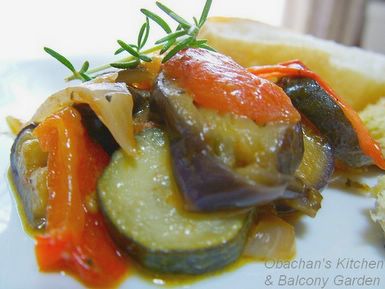 Ratatouille This was my very first time making (and eating) ratatouille, and I’m happy to tell you that it was a great success! Yes, what I have read on the net about this French dish was absolutely right. This is such a tasty, nutritious and hearty dish that you would want to recommend to someone. To be honest, I was a little skeptical before trying this out, because it was just vegetables with simple seasonings only -- with no meat or no soup stock. Even after seeing olive oil and garlic in the recipe, I still thought, “Wouldn’t it be rather tasteless?? Maybe only vegan people love this.” 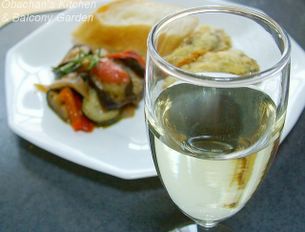 But oh, I was wrong – so very wrong – and I’m glad that I was. This is such a wonderful dish with all tasty flavors of summer vegetables condensed together! And yes, it is so good with French bread and white wine, and tastes great warm or cold, just like so many people mentioned on their websites. But oh, I was wrong – so very wrong – and I’m glad that I was. This is such a wonderful dish with all tasty flavors of summer vegetables condensed together! And yes, it is so good with French bread and white wine, and tastes great warm or cold, just like so many people mentioned on their websites.My dinner today consisted of baked breaded horse mackerel (with cheese and herbs), ratatouille, a few slices of French bread and Riesling wine. How about that? I must tell you that I enjoyed the tasty veggies on the bread slices, and finally wiped the plate with a piece of bread. Yum! BTW, I have been wanting to take a photo like this for a long time. 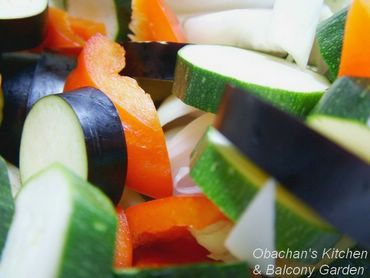 A close-up of cut vegetables... with nothing else, just vegetables. Nothing fancy, yet beautiful, refreshing and even healing (to me, at least). It's amazing how photogenic vegetables and fruits can be. I often think that they can be more photogenic than flowers. 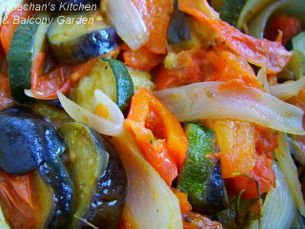 Now this simple and tasty dish has become my true favorite. I wish I would be able to make ratatouille with veggies from my own vegetable garden someday. Oh, that would be so wonderful, don't you think? Now this simple and tasty dish has become my true favorite. I wish I would be able to make ratatouille with veggies from my own vegetable garden someday. Oh, that would be so wonderful, don't you think?Categories: Western-inspired |
Posted by
obachan
at
8/05/2006 10:46:00 PM
10
comments
![]()
Labels: Vegetables
Tuesday, October 25, 2005
A Few Recipes to Use up Myoga Ginger
|
Posted by
obachan
at
10/25/2005 11:55:00 PM
13
comments
![]()
Labels: Deep-fried dish, Vegetables
October 26, 2005 |
Posted by
obachan
at
10/25/2005 11:53:00 PM
4
comments
![]()
Labels: Vegetables










































